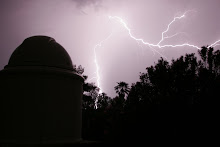
This was the second day of the Advanced Imaging Conference. I'm really in the presence of a lot of heavy hitters in the astro imaging world. It was definitely worth coming to the conference, I'm learning enough to keep me busy for quite a while.
The speakers and topics today included:
-David Malin, "From Darkroom to Digital" (Hubble Award Lecture);
-Jerry Bonnell, "Astronomy Picture of the Day";
-Rick Gilbert, "Remote Imaging Groups";
-Russell Croman, "Remote Observing";
-Michael Barber, "SBIG";
-Brad Ehrhorn, "RC Optical Systems";
-Steve Bisque, "Software Bisque";
-Joel Primack, "Flying Through the Hubble Deep Field";
-Adam Block, "Object Oriented Processing";
-Tony Hallas, "The Evolution of Dynamic Processing";
-Paul Mortfield, "Data Mining - Hidden Discoveries in Your Images".
After dinner there was a session on remote imaging with a 24" RCOS at an observatory at New Mexico Skies, but unfortunately it was cloudy so a full session wasn't possible. Nevertheless I saw enough today to make me excited about some image automation possibilities with my own gear.
That brings up a philosophical consideration. I personally love to be out under the skies and really be involved closely with my equipment as well. So in some ways, truly remote automated systems do not interest me all that much, it almost seems as thought the fun element goes away. I hope that I never reach the point where I lose my interest in sitting at an eyepiece on a quiet cool night.
However, there are so many little tasks involved with ccd imaging that automation does start to be attractive, especially when one considers that much of the mundane routine work could actually be taking precious time away from family and other activities. So, automating some of those processes does make sense. In addition, as I have mentioned before on this blog, working with the technology side of the astronomy hobby can be quite fulfilling. It's really neat when you get the computer talking to the telescope, or when you figure out a way to electronically control the focusser for a precision focus that would be impossible manually.
Anyway I hope to integrate some automation into the process going forward, if nothing else at least in the form of preparing an observing plan ahead of the night in order to maximize the available time for the session. One way I hope to do this is to use a new program that I purchased at AIC called CCDAutoPilot, published by CCDWare.
Tomorrow there is still more lecture time scheduled for the morning, and then Dean and I will have the long drive back to Tucson.
The picture above shows part of the vendor display area. The scope on the right is a 24" RCOS and on the left is a Paramount with several scopes on it, being run by CCDAutoPilot.
You can see more pictures from AIC taken by Michael Barber from SBIG by clicking here.

No comments:
Post a Comment